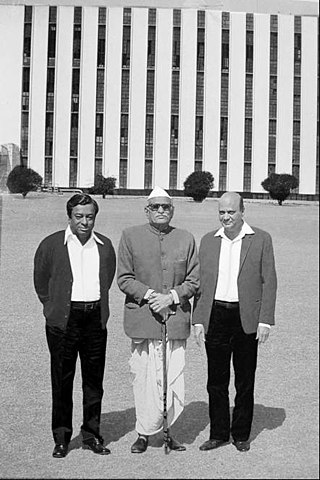Loading AI tools
White Revolution in India From Wikipedia, the free encyclopedia
The White Revolution, or Operation Flood, launched on January 13, 1970, was the world's largest dairy development programme and a landmark project of India's National Dairy Development Board (NDDB).[1] It transformed India from a milk-deficient nation into the world's largest milk producer, surpassing the United States in 1998 with about 22.29 percent of global output in 2018.[2][3] Within 30 years, it doubled the milk available per person in India[4] and made dairy farming India's largest self-sustainable rural employment generator.[5] The programme was launched to help farmers direct their own development and to give them control of the resources they create. It also promoted jersey cows and heavily increased lactose intolerance amongst Indians.[citation needed]

Dr Verghese Kurien, the chairman and founder of Amul, was named the Chairman of NDDB by Prime Minister Lal Bahadur Shastri. Kurien thrust the programme towards success and has since been recognised as its architect.[6] The making of skim milk powder out of buffalo milk, termed the Anand Pattern Experiment at Amul, was also instrumental to the program's success; the man who made this possible was Harichand Megha Dalaya, alongside Kurien.[7][8] It allowed Amul to compete successfully with cow milk-based suppliers such as Nestle.

Operation Flood is the programme that led to the "White Revolution." It created a national milk grid linking producers throughout India to consumers in over 700 towns and cities, reducing seasonal and regional price variations while ensuring that producers get a major share of the profit by eliminating the middlemen. At the bedrock of Operation Flood stands the village milk producers' co-operatives, which procure milk and provide inputs and services, making modern management and technology available to all the members.
Operation Flood's objectives included:-
Operation Flood was implemented in Three phases:

Phase I (1970–1980) was financed by the sale of skimmed milk powder and butter oil donated by the European Economic Community (EEC) through the World Food Program (WFP). NDDB planned the programme and negotiated the details of EEC assistance. During this phase, Operation Flood linked 18 of India's premier milk sheds with consumers in India's major metropolitan cities: Delhi, Mumbai, Kolkata, and Chennai, establishing mother dairies in the four metros.[9] Operation Flood-I was originally meant to be completed in 1975, but it eventually lasted until the end of 1979, at a total cost of Rs.1.16 billion.[10] At the start of Operation Flood-I, in 1970, certain aims were kept in view for the implementation of the programs:
Operation Flood Phase II (1981–1985) increased the number of milk sheds from 18 to 136; urban markets also expanded the outlets for milk to 290. By the end of 1985, a self-sustaining system of 43000 village co-operatives with 4,250,000 milk producers was covered. Domestic milk powder production increased from 22,000 metric tonnes in the pre-project year to 140,000 tonnes by 1989, with all of this increase coming from dairies set up under Operation Flood. In this way, EEC gifts and a World Bank loan helped promote self-reliance. Direct marketing of milk by producers' co-operatives also increased by several million liters a day.

Phase III (1985–1996) enabled dairy co-operatives to expand and strengthen the infrastructure required to procure and market increasing volumes of milk. Veterinary first-aid health care services, feed, and artificial insemination services for co-operative members were extended, along with intensified member education. Operation Flood's Phase III consolidated India's dairy co-operative movement, adding 30,000 new dairy co-operatives to the 43,000 existing co-operatives organised during Phase II. The number of milk sheds peaked at 173 in 1988–89, with the numbers of female members and female dairy cooperative societies increasing significantly. Phase III also increased emphasis on research and development in animal health and nutrition. Innovations such as a vaccine for Theileriosis, bypassing protein feed and urea-molasses mineral blocks, contributed to the enhanced productivity of milk-producing animals.[9]
Seamless Wikipedia browsing. On steroids.
Every time you click a link to Wikipedia, Wiktionary or Wikiquote in your browser's search results, it will show the modern Wikiwand interface.
Wikiwand extension is a five stars, simple, with minimum permission required to keep your browsing private, safe and transparent.